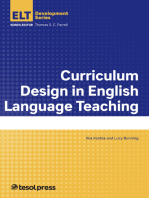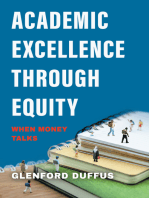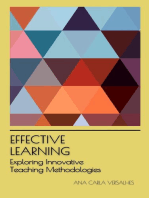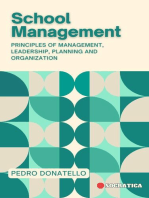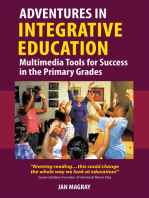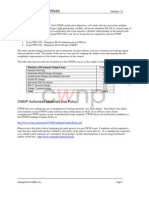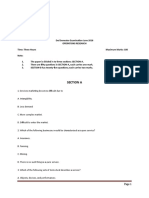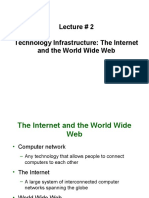0 ratings0% found this document useful (0 votes)
3 viewsDocument (5)
Lesson plan
Uploaded by
Naz Naz BaclidCopyright
© © All Rights Reserved
Available Formats
Download as DOCX, PDF, TXT or read online on Scribd
0 ratings0% found this document useful (0 votes)
3 viewsDocument (5)
Lesson plan
Uploaded by
Naz Naz BaclidCopyright
© © All Rights Reserved
Available Formats
Download as DOCX, PDF, TXT or read online on Scribd
You are on page 1/ 2
QUIZ No.
Name : Nazem Pandalat Section: A
Discuss the concept of curriculum, its major parts, and the various
types of curriculum that can be found in educational institutions. In
your answer, explain how each type of curriculum influences the
teaching-learning process and provide examples where applicable
(20pts.)
From my point of view, the concept of curriculum encompasses a
structured set of learning experiences, outcomes, and content that
educational institutions provide to students, involving what is taught, how it
is taught, and how learning is assessed. Major parts of a curriculum include
goals and objectives, content, learning experiences, and assessment. Goals
provide a broad vision of what students should achieve by the end of a
course or program. Content is selected based on relevance to real-world
situations, student interests, and academic standards. Learning experiences
are the instructional strategies and activities designed to engage students
effectively. Assessment can be formative or summative and may include
tests, quizzes, projects, and presentations.
Additionally, these various types of curriculum can be identified, each
influencing the teaching-learning process. These various curricula profoundly
shape children’s educational experiences in the Philippines. The formal
curriculum provides a standardized framework that ensures all students
receive a core set of knowledge and skills critical for their future endeavors.
However, the informal and hidden curricula play vital roles in shaping
students’ socio-emotional development, as they influence values and social
behaviors within school and community contexts. Exposure to diverse
experiences through extra-curricular activities fosters holistic development
by promoting life skills, teamwork, and creativity. The integrated curriculum
encourages students to think critically and recognize the relevance of their
learning in real-life scenarios, enhancing engagement and retention. Lastly,
the flexibility of the Senior High School tracks allows students to explore their
passions and prepare for their desired career paths, making education more
relevant and meaningful to their lives. Collectively, these curricula work
together to equip Filipino students with a well-rounded education that
nurtures both academic and personal growth, preparing them for the
complexities of the modern world.
To sum up all that has been stated, these diverse types of curriculum
work synergistically to create comprehensive educational experiences,
catering to the needs of a varied student population.
You might also like
- Gifted Education and Gifted Students: A Guide for Inservice and Preservice TeachersFrom EverandGifted Education and Gifted Students: A Guide for Inservice and Preservice TeachersNo ratings yet
- Watching Students Glo: General Learner Outcomes Build CharacterFrom EverandWatching Students Glo: General Learner Outcomes Build CharacterNo ratings yet
- Classroom-Ready Resources for Student-Centered Learning: Basic Teaching Strategies for Fostering Student Ownership, Agency, and Engagement in K–6 ClassroomsFrom EverandClassroom-Ready Resources for Student-Centered Learning: Basic Teaching Strategies for Fostering Student Ownership, Agency, and Engagement in K–6 ClassroomsNo ratings yet
- Leadership U.: Preparing Students for College, Career, and Beyond: Grades 11–12: Thriving in College and BeyondFrom EverandLeadership U.: Preparing Students for College, Career, and Beyond: Grades 11–12: Thriving in College and BeyondNo ratings yet
- Leadership U.: Preparing Students for College, Career, and Beyond: Grades 9–10: Preparing for Post-Secondary SuccessFrom EverandLeadership U.: Preparing Students for College, Career, and Beyond: Grades 9–10: Preparing for Post-Secondary SuccessNo ratings yet
- Mastering the Art of Lesson Planning: A Practitioner Guide for Teachers (Backed by Scientific Evidence)From EverandMastering the Art of Lesson Planning: A Practitioner Guide for Teachers (Backed by Scientific Evidence)5/5 (1)
- Innovative Teaching Methods: Empowering Educators for 21st Century Learning: Revolutionizing Education for the Modern WorldFrom EverandInnovative Teaching Methods: Empowering Educators for 21st Century Learning: Revolutionizing Education for the Modern WorldNo ratings yet
- Effective Learning: Exploring Innovative Teaching Methodologies: Innovative Education: Strategies, Challenges, and Solutions in PedagogyFrom EverandEffective Learning: Exploring Innovative Teaching Methodologies: Innovative Education: Strategies, Challenges, and Solutions in PedagogyNo ratings yet
- The Purpose and Practice of Education: A Critical Approach for Developing CurriculumFrom EverandThe Purpose and Practice of Education: A Critical Approach for Developing CurriculumNo ratings yet
- Learning & Study Guide for Adult Students: Teacher's ManualFrom EverandLearning & Study Guide for Adult Students: Teacher's ManualNo ratings yet
- Educational Psychology: Cognitive and Emotional Processes in Learning: Innovative Education: Strategies, Challenges, and Solutions in PedagogyFrom EverandEducational Psychology: Cognitive and Emotional Processes in Learning: Innovative Education: Strategies, Challenges, and Solutions in PedagogyNo ratings yet
- School Management: Principles of Management, Leadership, Planning and Organization: Innovative Education: Strategies, Challenges, and Solutions in PedagogyFrom EverandSchool Management: Principles of Management, Leadership, Planning and Organization: Innovative Education: Strategies, Challenges, and Solutions in PedagogyNo ratings yet
- Mastering the Art of Teaching: A Comprehensive Guide to Becoming an Exceptional EducatorFrom EverandMastering the Art of Teaching: A Comprehensive Guide to Becoming an Exceptional EducatorNo ratings yet
- Leadership U.: Preparing Students for College, Career, and Beyond: Grades 4–5: Seeing Oneself in CollegeFrom EverandLeadership U.: Preparing Students for College, Career, and Beyond: Grades 4–5: Seeing Oneself in CollegeNo ratings yet
- Learning Together: Building Relationships Through Educational ExperiencesFrom EverandLearning Together: Building Relationships Through Educational ExperiencesNo ratings yet
- Connecting Readers to Multiple Perspectives: Using Culturally Relevant Pedagogy in a Multicultural ClassroomFrom EverandConnecting Readers to Multiple Perspectives: Using Culturally Relevant Pedagogy in a Multicultural ClassroomNo ratings yet
- People Interacting: 150 Activities to Promote Self Awareness, Communication, Social and Problem-Solving SkillsFrom EverandPeople Interacting: 150 Activities to Promote Self Awareness, Communication, Social and Problem-Solving SkillsNo ratings yet
- Faculty Development Programs: Applications in Teaching and LearningFrom EverandFaculty Development Programs: Applications in Teaching and LearningNo ratings yet
- Together We Teach - Transforming Education Through Co-Teaching: Quick Reads for Busy EducatorsFrom EverandTogether We Teach - Transforming Education Through Co-Teaching: Quick Reads for Busy EducatorsNo ratings yet
- Leadership U.: Preparing Students for College, Career, and Beyond: Grades 6–8: Developing Key Life SkillsFrom EverandLeadership U.: Preparing Students for College, Career, and Beyond: Grades 6–8: Developing Key Life SkillsNo ratings yet
- Curriculum Compacting: An Easy Start to Differentiating for High Potential StudentsFrom EverandCurriculum Compacting: An Easy Start to Differentiating for High Potential Students5/5 (1)
- Content Matters: A Disciplinary Literacy Approach to Improving Student LearningFrom EverandContent Matters: A Disciplinary Literacy Approach to Improving Student LearningNo ratings yet
- The Structured Method of Pedagogy: Effective Teaching in the Era of the New Mission for Public Education in the United StatesFrom EverandThe Structured Method of Pedagogy: Effective Teaching in the Era of the New Mission for Public Education in the United StatesNo ratings yet
- Adventures in Integrative Education: Multimedia Tools for Success in the Primary GradesFrom EverandAdventures in Integrative Education: Multimedia Tools for Success in the Primary GradesNo ratings yet
- Using the National Gifted Education Standards for Pre-KGrade 12 Professional DevelopmentFrom EverandUsing the National Gifted Education Standards for Pre-KGrade 12 Professional Development3/5 (8)
- Is It Working in Your Middle School?: A Personalized System to Monitor Progress of InitiativesFrom EverandIs It Working in Your Middle School?: A Personalized System to Monitor Progress of InitiativesNo ratings yet
- Reverting To The Default Factory Configuration For The EX Series Switch - Technical Documentation - Support - Juniper NetworksNo ratings yetReverting To The Default Factory Configuration For The EX Series Switch - Technical Documentation - Support - Juniper Networks2 pages
- Experimental Investigation of Drilling Fluid Formulations and ProNo ratings yetExperimental Investigation of Drilling Fluid Formulations and Pro110 pages
- Mugomba-RegionalOrganisationsAfrican-1978No ratings yetMugomba-RegionalOrganisationsAfrican-197813 pages
- Quay Et Al (2022) Dewey's Education Through Occupations As Being-Doing-Knowing Creative Learning UnitsNo ratings yetQuay Et Al (2022) Dewey's Education Through Occupations As Being-Doing-Knowing Creative Learning Units17 pages
- ICPEP 2018 National Convention Invites FINAL v4No ratings yetICPEP 2018 National Convention Invites FINAL v41 page
- Wind Loading On A Hyperbolic Paraboloid Free Roof: Journal of Civil Engineering and Architecture October 2014No ratings yetWind Loading On A Hyperbolic Paraboloid Free Roof: Journal of Civil Engineering and Architecture October 201411 pages
- Blank Project Work Plan and Budget MatrixNo ratings yetBlank Project Work Plan and Budget Matrix2 pages
- Lake Milton Hydroelectric Project: Mahoning Hydropower, LLC100% (1)Lake Milton Hydroelectric Project: Mahoning Hydropower, LLC77 pages
- MANGO LEAF DISEASE DETECTION USING IMAGE PROCESSING TECHNIQUE - farhanPSM1No ratings yetMANGO LEAF DISEASE DETECTION USING IMAGE PROCESSING TECHNIQUE - farhanPSM147 pages
- Trends Networks and Critical Thinking in The 21st CenturyNo ratings yetTrends Networks and Critical Thinking in The 21st Century83 pages
- GS Yuasa eNITIME, Pilas Recargables NiMH LSD, Ficha Técnica InglésNo ratings yetGS Yuasa eNITIME, Pilas Recargables NiMH LSD, Ficha Técnica Inglés1 page
- Lecture # 2 Technology Infrastructure: The Internet and The World Wide WebNo ratings yetLecture # 2 Technology Infrastructure: The Internet and The World Wide Web35 pages
